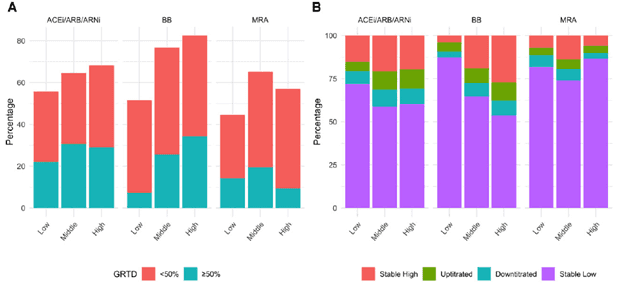
REPORT-HF study: is the prescription of guideline-recommended drugs for HFrEF (Heart Failure with reduced Ejection Fraction) optimal?

This is the question that we can ask ourselves after reading the very interesting article published this year in the European Heart Journal and entitled “Global disparities in prescription of guideline-recommended drugs for heart failure with reduced ejection fraction”1.
Heart Failure is a burning disease, with still a high mortality rate. However, solutions exist to reduce mortality, such as the early initiation of ACEi*, β-blockers and MRA** to improve outcomes in patients with heart failure with reduced ejection fraction (HFrEF).
The objective of the REPORT-HF study was to understand what are the global differences in prescription rates and target dose achievement of guideline recommended treatments for patients with HFrEF, according to country income level, and health insurance level.
8,669 patients with HFrEF hospitalized for acute heart failure from 44 different countries classed by level of income were followed for 6 months. This analysis aimed to assess the prescription patterns of 3 guideline-recommended therapies at discharge and 6-month follow up (RAS inhibitors***, β-blockers and MRAs), factors associated with their use in countries at different economic levels and the association of medication prescribing with 12-month mortality.
The results of the study shown that:
Of the 8,669 patients, only 37% were on all three medications (RAS inhibitors, β-blockers and MRAs). Among patients in low-income countries, only 19% of heart failure (HF) patients were on all three medications.
Only 52% of HF patients in low-income countries were receiving β-blockers (vs 84% in high income countries) and only 45% were receiving MRA (versus 59% in high income countries).
Rates of up-titration of any of the 3 guidelines recommended drug were low. For β-blockers, only 6% of patients from low-income countries were up-titrated to the guideline-recommended target doses.
Being on >50% of guideline-recommended target doses was independently associated with better 1-year survival, regardless of country income level. Patients up-titrated to >50% of guidelines recommended target doses had lower mortality.
Women, older patients, patients with new onset HF, from low-income countries, and without health insurance were less likely to be on these lifesaving medications such as ACEi* and β-blockers.
Stacked bar chart depicting the proportion of patients at discharge on guideline-recommended medical therapy and ≥50 of target dose at discharge stratified by country income level (A); up-titration of patients between discharge and 6-month follow-up stratified by country income level (B)
The results of this study strengthen the evidence that today there is still room from improvement for the optimization of HF therapy and for the prescription and up-titration of guideline-recommended drugs for HFrEF, regardless of the country's income level.
If you want to learn more about this topic, please find the study here.
- ACE inhibitors: Angiotensin-converting enzyme inhibitors
** MRA: Mineralocorticoid Receptor Antagonists
*** RAS: renin–angiotensin system inhibitors
To know more : Click here
1. Global disparities in prescription of guideline-recommended drugs for heart failure with reduced ejection fraction. Jasper Tromp et al. European Heart Journal, ehac103

Keep up to date with our content
Subscribe to our newsletter so that you are always up to date with the news.
